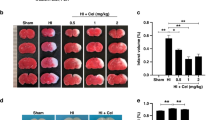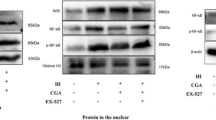Abstract
Background
Oxidative stress is involved in the development of hypoxic-ischemic brain damage (HIBD). In this study, we investigated the therapeutic effects of placenta-derived mesenchymal stem cells (PD-MSCs) and explored the NF-E2-related factor-2/heme oxygenase-1 (Nrf2/HO-1) signaling pathway in treating HIBD.
Methods
P7 rats were subjected to hypoxic-ischemic brain injury and randomly divided into four groups (control, HIBD, HIBD+PD-MSCs, and HIBD+fibroblasts). Forty-eight hours after the induction of HIBD, 5×105 of PD-MSCs were injected into cerebral tissue in the HIBD+PD-MSCs group, while the same dose of fibroblasts were injected in the HIBD+fibroblasts group. Morris Water Maze, gross and pathological changes were tested at P28. The level of malondialdehyde (MDA) was detected in rats’ hippocampus. RT-PCR and western blot analysis were used to evaluate the changes of Nrf2/HO-1.
Results
The HIBD group showed significantly longer escape latency and a lower frequency of original platform crossing in the Morris Water Maze compared with the control group. Rats receiving PD-MSCs showed significant improvement of HIBD. The pathological changes were evident after HIBD, but ameliorated in the PD-MSCs group. Compared with the control group, HO-1 and Nrf2 were up-regulated at gene and protein levels in the HI brain, beginning at 6 hours and peaking at 48 hours (P<0.05). The expression of HO-1 and Nrf2 in the PD-MSCs treatment group was more pronounced than in the HIBD group (P<0.01). PD-MSCs also decreased MDA production in the brain tissue.
Conclusion
These results demonstrate that PD-MSCs have neuroprotective effect during the treatment of HIBD and that the mechanism may be partly due to alleviating oxidative stress.
Similar content being viewed by others
References
Wagner BP, Nedelcu J, Martin E. Delayed postischemic hypothermia improves long-term behavioral outcome after cerebral hypoxia-ischemia in neonatal rats. Pediatr Res 2002;51:354–360.
Lubics A, Reglodi D, Tamás A, Kiss P, Szalai M, Szalontay L, et al. Neurological reflexes and early motor behavior in rats subjected to neonatal hypoxic-ischemic injury. Behav Brain Res 2005;157:157–165.
Baburamani AA, Ek CJ, Walker DW, Castillo-Melendez M. Vulnerability of the developing brain to hypoxic-ischemic damage: contribution of the cerebral vasculature to injury and repair? Front Physiol 2012;3:424.
Green DR, Galluzzi L, Kroemer G. Mitochondria and the autophagy-inflammation-cell death axis in organismal aging. Science 2011;333:1109–1112.
Alonso-Alconada D, Hilario E, Álvarez FJ, Álvarez A. Apoptotic cell death correlates with ROS overproduction and early cytokine expression after hypoxia-ischemia in fetal lambs. Reprod Sci 2012;19:754–763.
Vasiljević B, Maglajlić-Djukić S, Gojnić M, Stanković S. The role of oxidative stress in perinatal hypoxic-ischemic brain injury. Srp Arh Celok Lek 2012;140:35–41.
Shah ZA, Li RC, Thimmulappa RK, Kensler TW, Yamamoto M, Biswal S, et al. Role of reactive oxygen species in modulation of Nrf2 following ischemic reperfusion injury. Neuroscience 2007;147:53–59.
Lee JM, Calkins MJ, Chan K, Kan YW, Johnson JA. Identification of the NF-E2-related factor-2-dependent genes conferring protection against oxidative stress in primary cortical astrocytes using oligonucleotide microarray analysis. J Biol Chem 2003;278:12029–12038.
Shinkai Y, Sumi D, Fukami I, Ishii T, Kumagai Y. Sulforaphane, an activator of Nrf2, suppresses cellular accumulation of arsenic and its cytotoxicity in primary mouse hepatocytes. FEBS Lett 2006;580:1771–1774.
Brouard S, Otterbein LE, Anrather J, Tobiasch E, Bach FH, Choi AM, et al. Carbon monoxide generated by heme oxygenase 1 suppresses endothelial cell apoptosis. J Exp Med 2000;192:1015–1026.
Tanaka Y, Maher JM, Chen C, Klaassen CD. Hepatic ischemia -reperfusion induces renal heme oxygenase-1 via NF-E2-related factor 2 in rats and mice. Mol Pharmacol 2007;71:817–825.
Moisan A, Pannetier N, Grillon E, Richard MJ, de Fraipont F, Rémy C, et al. Intracerebral injection of human mesenchymal stem cells impacts cerebral microvasculature after experimental stroke: MRI study. NMR Biomed 2012;25:1340–1348.
Coquery N, Blesch A, Stroh A, Fernández-Klett F, Klein J, Winter C, et al. Intrahippocampal transplantation of mesenchymal stromal cells promotes neuroplasticity. Cytotherapy 2012;14:1041–1053.
Pimentel-Coelho PM, Magalhães ES, Lopes LM, deAzevedo LC, Santiago MF, Mendez-Otero R. Human cord blood transplantation in a neonatal rat model of hypoxic-ischemic brain damage: functional outcome related to neuroprotection in the striatum. Stem Cells Dev 2010;19:351–358.
Lee JA, Kim BI, Jo CH, Choi CW, Kim EK, Kim HS, et al. Mesenchymal stem-cell transplantation for hypoxic-ischemic brain injury in neonatal rat model. Pediatr Res 2010;67:42–46.
van Velthoven CT, Kavelaars A, van Bel F, Heijnen CJ. Mesenchymal stem cell treatment after neonatal hypoxicischemic brain injury improves behavioral outcome and induces neuronal and oligodendrocyte regeneration. Brain Behav Immun 2010;24:387–393.
Lee JM, Jung J, Lee HJ, Jeong SJ, Cho KJ, Hwang SG, et al. Comparison of immunomodulatory effects of placenta mesenchymal stem cells with bone marrow and adipose mesenchymal stem cells. Int Immunopharmacol 2012;13:219–224.
Griffin M, Bhandari R, Hamilton G, Chan YC, Powell JT. Alveolar type II cell-fibroblast interactions, synthesis and secretion of surfactant and type I collagen. J Cell Sci 1993;105:423–432.
Rice JE 3rd, Vannucci RC, Brierley JB. The influence of immaturity on hypoxic-ischemic brain damage in the rat. Ann Neurol 1981;9:131–141.
Crawley JN. What’s Wrong With My Mouse? Behavioral phenotyping of transgenic and knockout mice. Hoboken: New Jersey, 2007:63–84.
Nazarov I, Lee JW, Soupene E, Etemad S, Knapik D, Green W, et al. Multipotent stromal stem cells from human placenta demonstrate high therapeutic potential. Stem Cells Transl Med 2012;1:359–372.
Sun CK, Chang CL, Lin YC, Kao YH, Chang LT, Yen CH, et al. Systemic administration of autologous adipose-derived mesenchymal stem cells alleviates hepatic ischemia-reperfusion injury in rats. Crit Care Med 2012;40:1279–1290.
Chen YT, Sun CK, Lin YC, Chang LT, Chen YL, Tsai TH, et al. Adipose-derived mesenchymal stem cell protects kidneys against ischemia-reperfusion injury through suppressing oxidative stress and inflammatory reaction. J Transl Med 2011;9:51.
Hamedi-Asl P, Halabian R, Bahmani P, Mohammadipour M, Mohammadzadeh M, Roushandeh AM, et al. Adenovirus-mediated expression of the HO-1 protein within MSC decreased cytotoxicity and inhibited apoptosis induced by oxidative stresses. Cell Stress Chaperones 2012;17:181–190.
Joshi G, Johnson JA. The Nrf2-ARE pathway: a valuable therapeutic target for the treatment of neurodegenerative diseases. Recent Pat CNS Drug Discov 2012;7:218–229.
Irmak MK, Fadillioglu E, Sogut S, Erdogan H, Gulec M, Ozer M, et al. Effects of caffeic acid phenethyl ester and alphatocopherol on reperfusion injury in rat brain. Cell Biochem Funct 2003;21:283–289.
Brüning CA, Prigol M, Luchese C, Jesse CR, Duarte MM, Roman SS, et al. Protective effect of diphenyl diselenide on ischemia and reperfusion-induced cerebral injury: involvement of oxidative stress and pro-inflammatory cytokines. Neurochem Res 2012;37:2249–2258.
Author information
Authors and Affiliations
Corresponding author
Rights and permissions
About this article
Cite this article
Ding, HF., Zhang, H., Ding, HF. et al. Therapeutic effect of placenta-derived mesenchymal stem cells on hypoxic-ischemic brain damage in rats. World J Pediatr 11, 74–82 (2015). https://doi.org/10.1007/s12519-014-0531-8
Received:
Accepted:
Published:
Issue Date:
DOI: https://doi.org/10.1007/s12519-014-0531-8




